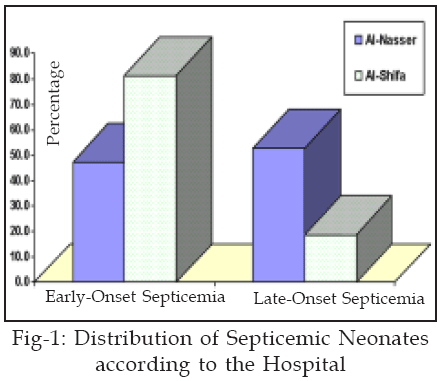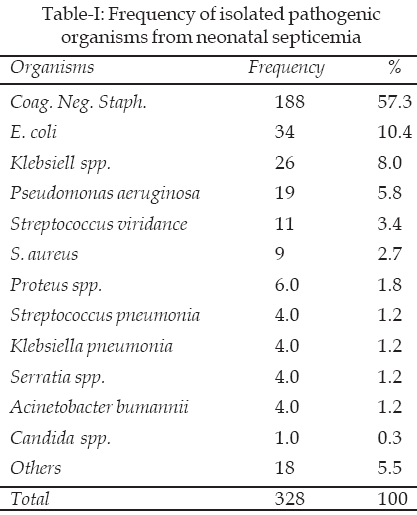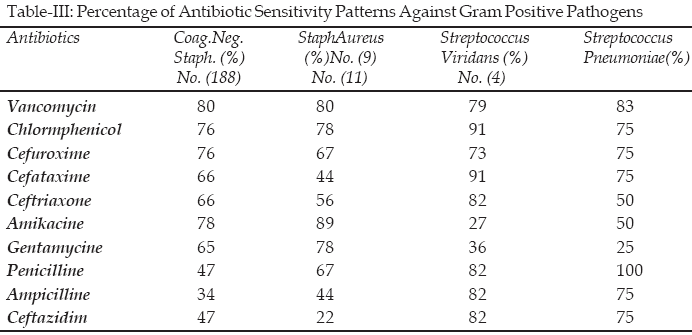|
|
||||
|
Published by : PROFESSIONAL MEDICAL PUBLICATIONS |
||||
|
ISSN 1681-715X |
||||
|
||||
|
- |
||||
|
ORIGINAL ARTICLE |
||||
|
- |
||||
|
Volume 25 |
April - June 2009 (Part-I) |
Number 2 |
||
|
|
||||
|
|
||||
|
|
||||
|
Published by : PROFESSIONAL MEDICAL PUBLICATIONS |
||||
|
ISSN 1681-715X |
||||
|
||||
|
- |
||||
|
ORIGINAL ARTICLE |
||||
|
- |
||||
|
Volume 25 |
April - June 2009 (Part-I) |
Number 2 |
||
|
|
||||
|
|
||||
Neonatal Septicemia in
Gaza City Hospitals
Abed El Hakeem Noman El Jadba1, Mansour Sobhi El Yazji2
ABSTRACT
Objective: To determine the most common pathogens and antimicrobial sensitivity of neonatal septicemia in Neonatal Intensive Care Units (NICU) in Gaza City hospitals.
Methodology: This prospective descriptive study was carried out in (NICU) in Al-Nasser and Al- Shifa hospitals in Gaza City, between January 2004 to January 2005. The patients were categorized into two groups of early and late onset septicemia.
Results: Three hundred twenty eight neonates out of 2487 cases had positive blood cultures with infection rate of 13.2%. The most common isolated pathogens were Coagulase negative Staphylococci, E. coli, and Klebsiella spp. These isolates were most sensitive to meropenem, amikacin, vancomycin, chloramphenicol, ciprofloxacine and third generation cephalosporine. The highest percentages of isolated pathogens were obtained from Al- Nasser hospital with infection rate of 52.9% for early onset sepsis and 84.5% for late respectively. While in Al-Shifa hospital the rate of early onset sepsis was 47.1% and 15.5% for late onset sepsis respectively.
Conclusion: There is a difference between the types of septicemia found in two hospitals (early onset and lately onset septicemia) with a prevalence of Coagulase negative staphylococci (57.3%), E. coli (10.4%), Klebsiella spp. (8.0%) and others (24.3%). The most effective antibiotic for Gram negative isolates was meropenem, while the most effective antibiotic for Gram positive isolates was vancomycin.
KEY WORDS: Septicemia, Neonates, Early Onset Sepsis, Late Onset Sepsis, Antimicrobial activity.
Pak J Med Sci April - June 2009 Vol. 25 No. 2 226-231
How to cite this article:
El-Jadba AHE, El-Yazji MS. Neonatal Septicemia In Gaza City Hospitals. Pak J Med Sci 2009;25(2):226-231.
1. Abed El Hakeem Noman El Jadba,
Al Dora Pediatric Hospital,
Gaza, Palestine.
2. Mansour Sobhi El Yazji,
Biology department,
Al-Aqsa University,
Gaza,
Palestine
Correspondence
Mansour Sobhi El Yazji,
E-mail: mansourelyazji@yahoo.com
Received for Publication: August 19, 2008
Revision Received: December 1, 2008
Final Revision Received January 29, 2009
Final Revision Accepted: January 31, 2009
INTRODUCTION
Neonatal septicemia is a clinical syndrome of bacteremia characterized by systemic signs and symptoms in first month of life.
1 Neonatal septicemia is one of the commonest cause of neonatal mortality and morbidity through out the world,2 it is estimated that 20% of all neonates develop sepsis3 and is responsible for 30-50% of total neonatal death in developing countries.4Septicemia in neonates refers to generalized bacterial infection documented by a positive blood culture in the first 4 weeks of life and is one of the four leading causes of neonatal mortality in India prior to the antibiotic era, where the mortality from septicemia was 90%, but it declined to 24-58% after antibiotics came into use.
Neonatal septicemia is a life-threatening clinical emergency that demands urgent diagnosis and treatment.
5 Neonatal sepsis is one of the most common reasons for admission to a neonatal unit in developing countries.6 About 50-88% of all neonatal deaths in the community are attributable to infectious causes and 22-66% of all admissions in the neonatal unit are due to infections including septicemia and pneumonia.7 The spectrum of organisms causing neonatal sepsis changes over time and varies from region to region it is probably due to changes in lifestyle.Gram negative organisms was found to be the most common cause of neonatal sepsis in Europe and America in 1960s, it changed to group B streptococci during 1970s, and Coagulase negative Staphylococcus was the most common cause during late 1980s and 1990s. In most of developing countries gram negative organisms are still the main cause of sepsis especially early onset neonatal sepsis.
6,8The most commonly isolated organisms from blood culture are gram positive cocci including Coagulase negative Staphylococci, Staphylococcus aureus, Enterococcus spp, and other organisms likely inhabit the hospitalized patients.
9Sepsis with gram negative microorganisms is increasingly reported nowadays particularly in Asia and other countries.
8,10 Bacteria reach the blood stream and the infection can spread to other organs such as lung, intestinal tract, liver, kidney and joints.11 Diagnosis is confirmed by growth of microorganisms in body fluid culture.12The problem of bacterial antibiotics resistance emerged as the first antibiotic became available for the clinical use. Multidrug resistance to antibiotics has developed over the last two decades.
8,13 Reasons for this increasing problem could be due to mutant forms of common bacteria, over use or under use of broad spectrum antibiotics, over the counter sale of antibiotics, poor sanitation and ineffective infection control in the maternity services. Multidrug resistant strains of gram-negative enteric organisms e.g.; Klebsiella spp are known to flourish in the presence of third generation cephalosporin.14Classification of neonatal septicemia is useful as it facilitates consideration of common principles of causation, presentation and treatment.
15 There are two patterns of septicemia described during the first month of life, early-onset (EOS) and late-onset (LOS).16 EOS disease presents as a fulminant multisystem illness during the first 5-7 days of life, whereas (LOS) disease is most commonly recognized after the first week of life.17 Infection presenting within the first 48 hours of life is generally classified as (EOS) infections although, definitions range from 24 hour to 7 days. This category of infections is commonly caused by microorganisms acquired from the mother before or during birth.15 It is frequently associated with obstetric complications, such as premature rupture of membranes, premature onset of labor, chorioamnionitis and peripartum maternal fever. The majority of affected newborns are premature or low birth weight infants and the pathogens are frequently acquired during passage through the birth canal.Philip,
18 reported that E. coli, Listeria monocytogenes, Haemophilus influenza, Enterobacter spp, Klebsiella pneumonia, Pseudomonas aeruginosa and Staphylococcus aureus are the microorganisms commonly isolated from infants with EOS. The mortality rate in (LOS) septicemia is lower than the early onset septicemia. Bacteria responsible for late-onset septicemia include those acquired from the maternal genital canal and organisms acquired after birth from human contacts or from contaminated equipment or materials.19Therefore, the present study was designed and aimed to determine the most common pathogenic organisms and antimicrobial sensitivity of neonatal septicemia in NICU in the two hospitals (Al Nasser and AL Shifa hospitals) in Gaza City. The objective of the present study included Isolation of the bacteria which causes septicemia and to determine the antibiogram for the isolated pathogens.
METHODOLOGY
Study population: Two thousand four hundred eighty seven blood samples were collected from neonates through 28 days who were admitted to NICU Al-Nasser and Al-Shifa hospitals in Gaza City and diagnosed clinically as septicemia. They were analyzed for the presence of bacteria during the period of January 2004 to January 2005.
Blood samples: Blood samples were collected with all aseptic precautions for blood culture and sensitivity studies, inoculated into bottles containing Trypticase Soya Broth for isolation of aerobic bacteria. The blood culture bottles were incubated at 37
0C and sub cultured on solid media (blood agar, MacConckey agar and Chocolate agar) after 24hr to 48hr and at 7 days. Isolates were identified by Gram stain and conventional biochemical methods.Antibiotic susceptibility test: The isolated pathogens were tested for the antibiotics susceptibility test. The method used was the disk diffusion method which principally depends on the determination of minimum inhibition concentration and the inhibition zones are measured. The calibrated inoculums of the pathogenic microorganism at 0.5 concentration of McFarland standard were inoculated into Muller Hinton media and the antibiotic disks were placed on the surface of plates. Inhibition zones were determined after incubation at 37
0C for 24hr.Clinical data for each neonate was collected and included the information such as: Neonate name, date of admission, type of delivery, gestational age, gender, body weight, clinical diagnosis on admission, length of hospitalization, pathogenic microorganisms and their antibiotic susceptibilities.
RESULTS
All hospitalized neonates in the (NICU) in Al-Shifa and Al- Nasser hospitals were included in this study. A total of 2487 were investigated in the two hospitals over the period from January 2004 to January 2005. Three hundred twenty eight neonates were found to be positive for the presence of bacteria in the blood culture with contamination rate of 13.2%. Isolated pathogens in Al -Nasser hospital with early and late onset of sepsis was 47.2% (102) and 52.8% (114) respectively whereas the early and late onset of sepsis in Al- Shifa hospital were 81.2% (91) and 18.8% (21) respectively as shown in Fig-1.

The samples from septicemic patients were investigated for isolation of pathogenic organisms. The number of isolated pathogenic microorganisms was twenty one types of isolates; these isolated pathogens have different kinds and comprised: (68.3%). Gram positive, (31.4%), Gram negative and (0.3%) Candida spp. Table-I.

Table-II shows the antibiotic susceptibility pattern for Gram negative pathogens, with a considerable variation in the response of different isolates. The most susceptible antibiotic was Meropenem, follwed by Amikacin, Ceftriaxone, Chloramphenicol, Ciprofloxacin, Cefuroxime, Gentamycin, Ceftazidim, Cefataxime, Pipracellin and Ampicillin.

Table-III shows the antibiotic susceptibility pattern for Gram positive, with aconsiderable variation in the response of different isolates. The most susceptible antibiotic was Vancomycin, followed by Chloramphenicol, Cefuroxime, Cefataxime, Ceftriaxone, Amikacin, Gentamycin, Penicillin and Ceftazidim.

DISCUSSION
The rate of contamination of blood culture in the microbiology laboratory of Al-Shifa hospital and Al- Nasser hospital was high (13.2%) especially in comparison with other hospitals in other countries.
20 One important source of contamination of blood cultures with bacteria such as S. epidermidis, Diphtheroid spp. and Bacillus spp. is the insufficient disinfection materials. In our hospital, physicians often submit one or two instead of three samples, making the interpretation of blood culture results difficult.21The role of Coagulase negative Staphylococci in the production of bacteremia is still controversial. Until the 1970s Coagulase negative Staphylococci were mainly recognised as contaminant i.e; as part of the skin flora. Since then, several studies have reported increasing incidence of infections due to Coagulase negative Staphylococci.
22,23 In our study it is lower to that reported for other neonatal units in developing countries with 61%, Gram positive cocci, 38%, Gram negative bacilli and 0.3% fungi.In the present study, Gram positive organisms constituted the major group of isolates 68.3%, from neonatal septicemic cases. Amongst this group, Coagulase negative staphylococci and S. aureus were the first and second most common etiologic agents respectively causing nosocomial blood stream infections in the USA.
24 In another study S. aureus and E. coli were the most commonly isolated blood stream infections followed by Enterococci, Klebsiella spp. Enterobacter spp., Pseudomonas aeruginosa, Streptococcus pneumonia and ß-hemolytic Streptococci were also along the 10 most frequently reported species in both USA and Canada.25Comparatively low incidence (38%) of Gram negative organisms has been observed in our study with the predominance of Escherichia coli (10.4%), followed by Klebsiella spp. (8.0%), Pseudomonas aeruginosa (5.8%), Proteus spp. (1.8%), Klebsiella pneumonae (1.2%), Serratia spp. (1.2%) which is considered less than that found in other studies.
26,27Analysis of the trend of antimicrobial resistance among the leading pathogens causing sepsis revealed that Coagulase negative Staphylococci and S. aureus isolates were resistant to Ampicillin. Ampicillin resistance was seen in 18% of Streptococcus viridance and 25% of Streptococcus pneumonia. Vancomycin was the most effective for Gram positive. Coagulase negative Staphylococci showed 80% of the isolates were susceptible, also 80% of S. aureus, 79% of Streptococcus viridance and 83% of Streptococcus pneumonia. For Gram negative bacteria, the most effective drug was Meropenem, followed by Amikacin, Ceftriaxone, Chloramphenicol and Ciprofloxacin. For most of the organisms Aminoglycosides and Penicillin were effective. In our hospitals we continue use of these agents in initial empiric treatment of septicemic neonates. WHO also recommended use of Penicillin or Ampicillin plus an Aminoglycoside for infants below age of two months.
CONCLUSION
The present study reveals that there is a difference between the types of septicemia found in two hospitals (early onset and lately onset septicemia) with a prevalence of Coagulase negative staphylococci (57.3%), E. coli (10.4%), Klebsiella spp. (8.0%) and others (24.3%). The most effective antibiotic for Gram negative isolates was meropenem, while the most effective antibiotic for Gram positive isolates was vancomycin.
Recommendations: We recommend the use of Meropenem and Amikacin for gram negative bacteria, a combination of vancomycin and cefuroxine for gram positive bacteria, besides rotations in the use of antibiotics according to culture results to reduce the resistance.
REFERENCES
1. Jain NK, Jain VM, Maheshwari S. Clinical profile of neonatal sepsis, Kathmandu University Med J 2003;1(2):117-20.
2. Pawa AK, Ramji S, Prakash K, Thirupuram S. Neonatal nosocomial infections: profile and risk factors. India J Paediatr 1997;34:297-302.
3. Gotoff SP. Neonatal sepsis and meningitis: in Nelson textbook of paediatrics. (15th Ed). Eds Behraman RE, Kleigman RM, Arbin AM. Philadelphia. WB Saunders company 1996;528-37.
4. Agrawal R, Sarkar N, Deorary AK, Paul VK. Sepsis in newborn. Ind J Paediatric 2003;68:1143-7.
5. Higgins C. Microbiological examination of blood for septicemia, Nurs Time 1995;34-5.
6. Anwer SK, Mustafa S, Pariyani S, Ashraf S, Taufiq KM. Neonatal sepsis an etiological study. J Pak Med Assoc 2000;50:91-4.
7. Bhutta ZA. Epidemiology of neonatal sepsis in Pakistan: an analysis of evidence and implications for care. J Coll Physicians Surg Pak 1996;6:12-7.
8. Joshil SJ, Golem VS, Niphadkar KB. Neonatal gram negative bacteremia. India J Pediatr 2000;67:27-32.
9. Rahbar M, Gra-Agaji R, Hashemi S. Nosocomial blood stream infections in Imam Khomeini Hospital, Urmia, Islamic Republic of Iran, 1999-2001. La revue de Sante de Ia Mediterranee orientale 2005;11(3):478-84.
10. Bark AF. Intravenous lines-related sepsis in newborn babies admitted to NICU in a developing country. J Trop Pediatr 2003;49(5):259-7.
11. Brewer BD. Neonatal infection, In Koterba, AM, Drummond, WH, and Kosch, PC: Equine Clinical Neonatology, Philaedelphia 1990;295-316.
12. Bhutta ZA, Yousuf K. Neonatal sepsis in Karachi: Factor determining outcome and mortality, J Trop Pediatr 1997;43:65-70.
13. Friedman S, Shah V, Ohlsson A, Matlow AG. Neonatal Escherichia coli infections: concerns regarding resistance to current therapy. Acta Paediatr 2000;89:686-9.
14. Bhutta ZA, Naqvi SH, Muzaffar T, Farooqi BJ. Neonatal sepsis in Pakistan presentation and pathogens. Acta paediatr Scand 1991;80:596-601.
15. Rodrigo I. Changing patterns of neonatal sepsis, Sri Lanka J Child Health 2002;31:3-8.
16. Jiang JH, Chiu NC, Huang FY, Kao HA, Hsu CH, Hung HY, Peng CC. Neonatal sepsis in the neonatal intensive care unit: characteristics of early versus late onset. J Microbiol Immunol Infect 2004;37:301-6.
17. Agnihotri N, Kaistha N, Gupta V. Antimicrobial susceptibility of isolates from neonatal septicemia. Jpn. Infect Dis 2004;57:273-5.
18. Philip AG. The changing face of neonatal infection: experience at a regional medical centre. Pediatr Infect Dis J 1994;13:1098-1102.
19. Yurdakok M. Antibiotic use in neonatal sepsis, Turk J Pediatr 1998;40(1):17-33.
20. Luzzaro F. Prevalence and susceptibility of pathogens causing blood stream infections in North Italy. A two year study in 16 hospitals. European J Clinical Microbiology and Infectious Diseases 2002;21:849-55.
21. Chamdrasekar PH, Brown WJ. Clinical issues of blood culture. Archives of Internal Medicine 1994;145:841-9.
22. Boisson K. Characterization of Coagulase negative Staphylococci isolated from blood infections. Incidence, susceptibility to glycopeptides and molecular epidemiology. European J Clinical Microbiology and Infectious Disease 2002;21:660-5.
23. Thylefors JD, Harbarth S, Pttet D. Increasing bacteremia due to Coagulase negative Staphylococci. Fiction of reality? Infection control and hospital epidemiology 1998;19:581-9.
24. Marshall SA. Staphylococcus aureus and Coagulase negative Staphylococci from blood stream infections. Frequency of occurrence antimicrobial susceptibility and molecular characterization of Oxacillin resistance in the SCOPI program. Diagnostic Microbiology and Infectious Diseases 1996;30:205-14.
25. Pfaller MA. Bacterial pathogens isolated from patients with blood stream infection. Frequencies of occurrence and antimicrobial susceptibility patterns from the SENTRY antimicrobial surveillance program. (United State of America and Canada (1997). Antimicrobial Agents and Chemotherapy 1998;42:1762-70.
26. Choudhary P, Shrivastava DS, Agrawal L. Bacteriological study of neonatal infections. Indian Pediatr 1975;12:459-63.
27. Guha Dk, Jaspal D, Krishna Das Ms. Outcome of neonatal Septicemia, clinical and bacteriological profile. Indian Pediatr 1978;15:423-7.
HOME | SEARCH | CURRENT ISSUE | PAST ISSUES
Professional
Medical Publications
Room No. 522, 5th Floor, Panorama Centre
Building No. 2, P.O. Box 8766, Saddar, Karachi - Pakistan.
Phones : 5688791, 5689285 Fax : 5689860
pjms@pjms.com.pk